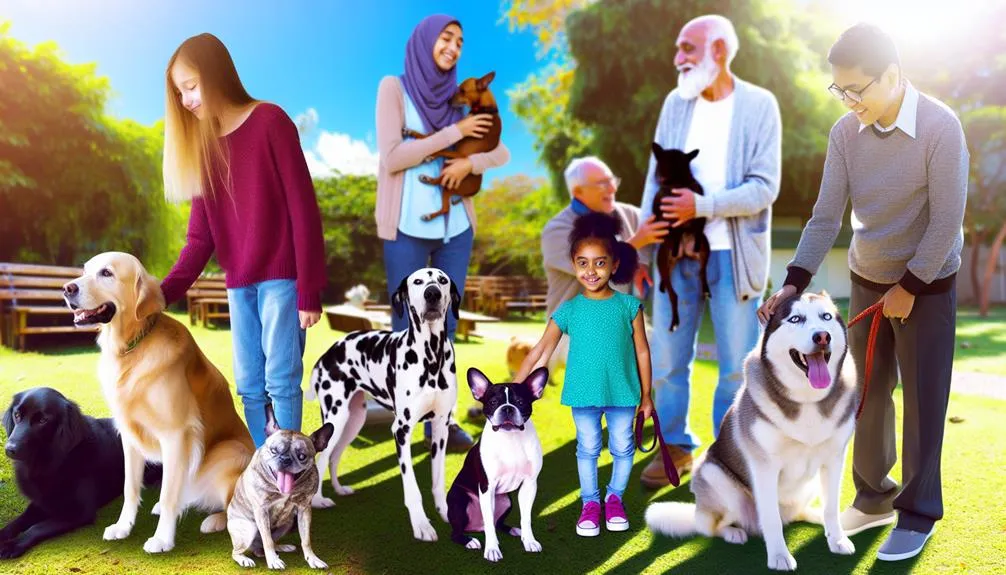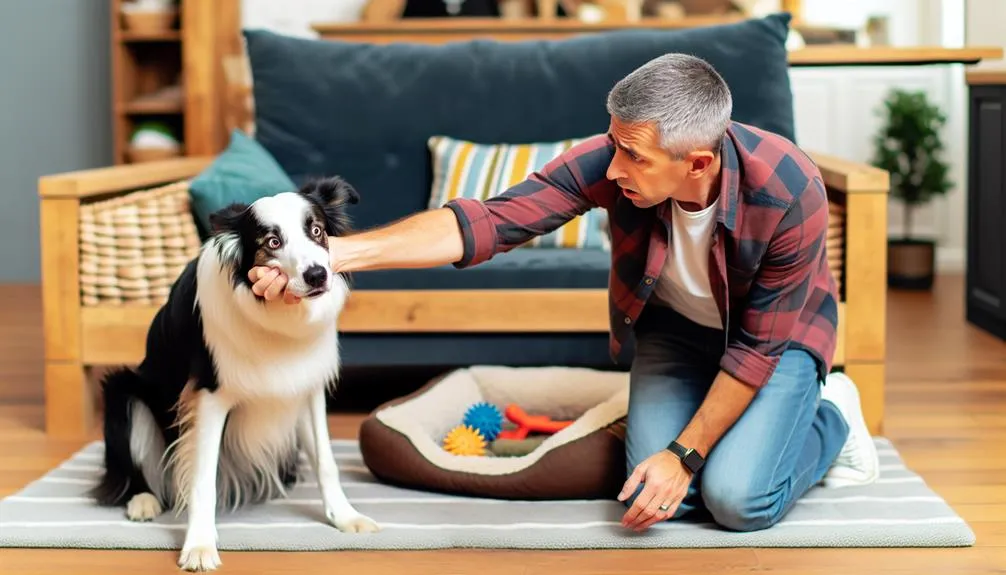
Do Dogs Like Being Pet
Did you know that over 80% of dog owners report their pets enjoy being petted? While this statistic suggests a strong general preference, the reality is more nuanced, as not all dogs react the same way. You might find that your dog enthusiastically leans into your hand, while others might shy away or show signs of discomfort. Understanding the subtle cues in their body language can make all the difference in ensuring a positive interaction. So, what are the signs that indicate your dog truly appreciates your affection?
Understanding Canine Body Language
Understanding canine body language is vital for interpreting how dogs feel about being petted. Dogs communicate their emotions and comfort levels through various physical cues, and recognizing these signs can help you guarantee a positive interaction. One key indicator is tail wagging. While many people associate tail wagging with happiness, it's important to pay attention to the speed and height of the wag. A slow, low wag might indicate uncertainty or submission, while a rapid, high wag usually signals excitement and enthusiasm.
Another significant aspect is ear position. Dogs' ears can reveal a lot about their mood. If your dog's ears are perked up and facing forward, it's likely they're engaged and curious. Conversely, if the ears are pinned back against the head, this could signal fear or discomfort. Understanding these subtle cues allows you to gauge whether your dog is receptive to petting or if they need some space.
It's also worth noting that every dog is different, and individual personalities can influence how they express themselves. Some dogs may enjoy touch more than others, regardless of their body language. By being attentive to these signals, you can foster a deeper bond and create a more enjoyable experience for both you and your furry friend. Ultimately, your ability to read canine body language will enhance your relationship, guaranteeing that your dog feels safe and understood.
Signs Your Dog Enjoys Petting
When you're petting your dog, it's vital to recognize the signs that indicate they're enjoying the interaction. Dogs communicate their feelings through body language and vocalizations, so paying close attention can enhance your bond with your furry friend. One clear indicator is tail wagging. If your dog's tail is wagging enthusiastically, especially if it's held high, it typically means they're feeling happy and relaxed.
Another sign to look for is happy noises. If your dog is making soft whines, grunts, or even playful barks while you're petting them, it's a strong indication they're enjoying the moment. These sounds often reflect excitement and contentment, signaling that they appreciate your affection.
Additionally, if your dog leans into your hand or nudges you for more petting, this is a clear request for further interaction. The more they seek your touch, the more likely they are to enjoy it. Likewise, relaxed body posture—such as a loose stance or slightly closed eyes—can indicate comfort and pleasure.
Conversely, if you notice signs of discomfort, like stiffening, avoiding eye contact, or turning away, it's important to respect those signals and give them space. Understanding these cues helps create a positive experience for both of you. By recognizing these signs, you can guarantee that your petting sessions are enjoyable and fulfilling, strengthening your emotional connection with your dog.
Factors Influencing Petting Preferences

Petting your dog might seem like a straightforward act, but several factors can influence how much they enjoy it. Understanding these factors can help you connect with your furry friend on a deeper level.
First, consider individual dog personalities. Just like people, dogs have their own unique temperaments. Some dogs thrive on affection and enjoy being petted extensively, while others may prefer minimal contact. Observing your dog's reactions can provide insights into their preferences. For instance, a shy dog might shy away from prolonged petting, indicating a need for personal space.
Breed-specific tendencies also play a notable role in petting preferences. Certain breeds are known for their affectionate nature, such as Golden Retrievers and Labradors, who often seek out human interaction. Conversely, breeds like Shiba Inus or Basenjis may be more independent and less inclined to seek out petting. Recognizing these tendencies can guide you in tailoring your approach to fit your dog's needs.
Additionally, the context in which petting occurs matters. A calm environment may encourage your dog to relax and enjoy the moment, while a chaotic setting may make them anxious. Factors like your dog's age, health, and past experiences can also contribute notably to their comfort level with being petted.
Best Techniques for Petting Dogs
While every dog is different, employing the right techniques for petting can greatly enhance their enjoyment of the experience. To start, always approach a dog calmly and allow them to initiate contact. This respects their boundaries and promotes dog comfort. Once you're in close proximity, observe their body language—relaxed ears and wagging tails indicate openness to interaction, while stiff bodies or tucked tails suggest hesitation.
When it comes to petting techniques, begin with gentle strokes on the side of the dog's neck or behind the ears. These areas are typically less threatening and often favored by many dogs. Use an open palm rather than a grabbing motion, as this creates a more soothing experience. Gradually shift to longer strokes along their back, which can be particularly enjoyable for them.
Pay attention to their reactions; a dog leaning into your hand or nudging for more contact is a positive sign. Conversely, if they pull away or seem tense, it's crucial to respect their feelings. You might also try varying your pressure—some dogs prefer light, gentle touches, while others enjoy a firmer hand.
Incorporating breaks during your petting session can also enhance dog comfort. This gives them the opportunity to engage with you on their terms, reinforcing a trusting bond. By being mindful of individual preferences and adapting your petting techniques accordingly, you'll create a more enjoyable and enriching experience for both you and your canine companion.
When to Avoid Petting Your Dog

Sometimes, even the friendliest dogs aren't in the mood for affection, and it's important to recognize those moments. Petting your dog when they're stressed or anxious can exacerbate their discomfort. Signs of dog stress include tucked tails, flattened ears, and avoidance behaviors. If you notice any of these signals, it's best to respect your dog's petting boundaries and give them some space.
Moreover, situations like vet visits, thunderstorms, or unfamiliar environments can heighten your dog's anxiety. In these instances, your attempts at affection may not be received well. Instead of comforting them through petting, focus on creating a calm atmosphere. You might find that your presence alone is enough, as dogs often seek security in familiar companions.
Additionally, when your dog is engaged in play or focused on a task, interrupting them with petting can lead to frustration. Respecting their moment of concentration not only shows understanding but also strengthens your bond.
Lastly, if you're meeting a new dog, it's critical to gauge their comfort level before initiating contact. Not every dog is open to immediate affection from strangers. Approach slowly, observe their body language, and allow them to come to you if they choose.
Frequently Asked Questions
Do All Dog Breeds Enjoy Being Petted?
Not all dog breeds enjoy petting equally. Individual temperament plays an essential role; while some breeds thrive on affection, others may prefer space. Understanding each dog's unique preferences can enhance your bond and their comfort.
Can Petting Be Harmful to Some Dogs?
Petting isn't always beneficial; it depends on the dog's body language and petting preferences. Some dogs may feel anxious or uncomfortable with too much contact. Observing their cues helps guarantee a positive experience for both of you.
How Long Should I Pet My Dog?
When you're petting your dog, pay attention to their comfort. Use gentle petting techniques, starting with short sessions of about 5-10 minutes. Adjust based on their reactions; every dog has different preferences and comfort levels.
Can I Pet a Dog I Don't Know?
When petting a dog you don't know, observe its body language first. If it seems relaxed and approaches you, gentle, appropriate petting can be fine. Always respect the dog's comfort level to guarantee a positive interaction.
Do Dogs Prefer Petting Over Verbal Praise?
When considering petting preferences, it's essential to recognize that while many dogs enjoy physical affection, praise effectiveness varies. Individual dogs may respond differently, so observing their reactions can help guide your approach for ideal interaction.
Conclusion
In summary, while many dogs relish human touch, it's crucial to recognize their individual preferences and body language. Studies show that nearly 60% of dogs exhibit signs of enjoyment when petted correctly, but that still leaves a significant number who may feel uncomfortable. By observing your dog's cues and adjusting your approach, you can enhance your bond and guarantee a positive experience for both of you. Always remember, understanding your dog's needs is key to a happy relationship.
You may also like
Archives
Calendar
| M | T | W | T | F | S | S |
|---|---|---|---|---|---|---|
| 1 | 2 | 3 | 4 | 5 | 6 | |
| 7 | 8 | 9 | 10 | 11 | 12 | 13 |
| 14 | 15 | 16 | 17 | 18 | 19 | 20 |
| 21 | 22 | 23 | 24 | 25 | 26 | 27 |
| 28 | 29 | 30 | ||||
Leave a Reply